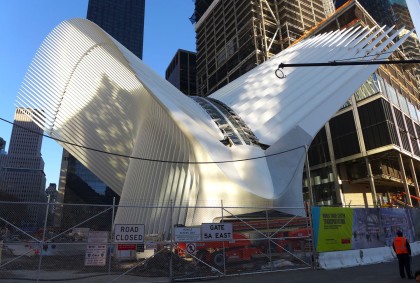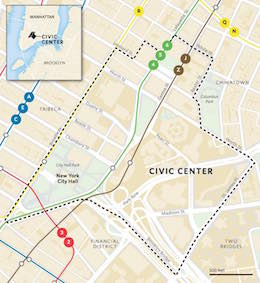Categories
Left column house ads
In the News: First Reviews of the World Trade Center Oculus
February 22, 2016 Real Estate, Restaurant/Bar News, Services, Shopping
 ••• A visit to the World Trade Center Transportation Hub didn’t make the New York Post‘s Steve Cuozzo any fonder of it:
••• A visit to the World Trade Center Transportation Hub didn’t make the New York Post‘s Steve Cuozzo any fonder of it:
The ribs rising to a 22- foot-wide skyline frame an impressive ovoid space, for sure. How could a white marble floor 392 feet long, 144 feet wide and a ceiling 160 feet high at its apex not be impressive? But what will the public find on the vast, 56,448- square-foot floor? Nothing. Not a seat. No newsstands or snack concessions. No central information kiosk like the one that provides a focus to the main hall of Grand Central Terminal, to which Calatrava and the Port Authority presumptuously compare the hub. Why? An empty floor was Calatrava’s idea. But also, the PA plans to pimp out the Oculus as an event venue, and any installations would get in the way.” Would you really want snack concessions there? Also of note: “The March opening will allow access only from PATH platforms to the west. Commuters will find a lifeless void until 75,000 square feet of stores around its perimeter on two levels open when leaseholder Westfield gets around to it and until myriad under-construction elevators and escalators connect with subway lines and nearby office buildings. The passageways, to open later this year, will let you walk underground all the way from Brookfield Place in Battery Park City to William Street via the MTA’s Fulton Center.”
••• Justin Davidson of New York magazine thinks otherwise. His review ends with a lovely bit of writing:
Cost is an objective fact; value isn’t. Whether you consider this station splendid overkill, an ugly boondoggle, or a lasting work of genius depends on a host of intangibles. Granted, you can move 100,000 commuters in and out of New Jersey every day a good deal more modestly and cheaply. (Penn Station manages five or six times that number of passengers.) But the Hub serves an area that is both the oldest and newest part of town, and keeps changing in ways that planners have never been able to predict. There’s a good chance that more commuters will arrive as new offices materialize, old ones become apartments, and the neighborhood acquires residents who will flow through the oculus in search of dinner, a shirt, or a meeting spot. I doubt it will ever feel empty. In the end, we are left with a structure that must endure a century or more. Calatrava’s skeletal dove joins the tiny circle of New York’s great indoor public spaces, serving not just the city that built it but also the city it will help build.
••• Three small businesses—a nail salon, newsstand, and deli—are being forced to leave Gateway Plaza in Battery Park City to make way for another Le Pain Quotidien. —Broadsheet
••• Tribeca Trib has a Q&A with Best Market manager Edwin Gomez. Alas, he was not asked about the “ass donut” sign, which I’ve decided must’ve been shorthand for “assorted donuts” and not the work of a disgruntled employee.
 ••• The Wall Street Journal has one of those “living in” real estate articles about the neighborhood no one calls Civic Center, which it defines rather oddly. (See the map at right.) My favorite line: “Major retailers can be found along Broadway, Chambers, Worth and Reade streets.” That’s right! Spend a day browsing Duane Reade, Modell’s, Lot-Less, and Bolton’s.
••• The Wall Street Journal has one of those “living in” real estate articles about the neighborhood no one calls Civic Center, which it defines rather oddly. (See the map at right.) My favorite line: “Major retailers can be found along Broadway, Chambers, Worth and Reade streets.” That’s right! Spend a day browsing Duane Reade, Modell’s, Lot-Less, and Bolton’s.
••• A Wall Street Journal article on midcentury Brazilian design includes Espasso, of course, but also R & Company, which is co-publishing a book called Brazil Modern next month, and Tribeca interior designer Damon Liss.
••• Inside Café Altro Paradiso, the Estela spin-off at Spring and Sixth, opening tomorrow. (Why not Caffé, I wonder.) —Grub Street
5 Comments
Comment:
Subscribe
Subscribe to the TC Newsletter













I’m bummed that the reporter didn’t get to the bottom of the ass donuts! It wouldn’t have been too cheeky to ask.
Love it!
Lol…
It must have slipped through the crack.
While Calatrava’s monument to marble adds to the overload of stark, extreme neat, clean and anti-septic architecture of the rebuilt Ground Zero, like some sort of subconscious effort to obliterate all memory of destruction, pain, shock, heroism and sacrifice of 9/11, an authentic piece of that memory sits forgotten in an abandoned corner of Battery Park. The battered and bruised Koenig Sphere, the only remaining intact artifact of the WTC. It has been deemed too offensive, too ugly, to real to be returned to the WTC and the billion dollar, “National September 11 Memorial.” It would infringe upon “healing” – and our happy selfies. To help return the Sphere, please Facdbook, Save the Sphere